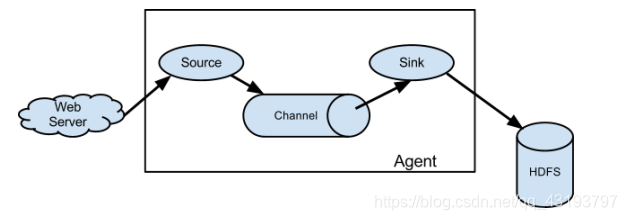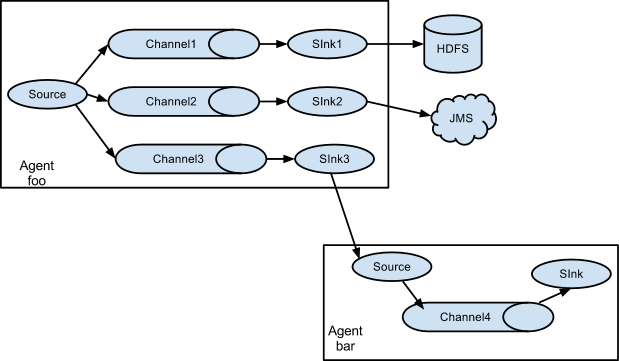将本地数据从本地导入到HDFS上,其实可以利用IO流的形式,在Inputformat中读取文件,作为输入,在Mapper中输出即可。而Flume就是提供类似功能的框架。
一、Flume 简介
1) Flume 提供一个分布式的,可靠的,对大数据量的日志进行高效收集、聚集、移动的服务, Flume 只能在 Unix 环境下运行。
2) Flume 基于流式架构,容错性强,也很灵活简单。
3) Flume、Kafka 用来实时进行数据收集,Spark、Storm 用来实时处理数据,impala 用来实 时查询。
二、Flume 角色

2.1、Source
用于采集数据,Source 是产生数据流的地方,同时 Source 会将产生的数据流传输到 Channel, 这个有点类似于 Java IO 部分的 Channel。
2.2、Channel
用于桥接 Sources 和 Sinks,类似于一个队列。 (应用的解耦,将source和sink解耦,每个Channel绑定一个sink)
2.3、Sink
从 Channel 收集数据,将数据写到目标源(可以是下一个 Source,也可以是 HDFS 或者 HBase)。
2.4、Event
传输单元,Flume 数据传输的基本单元,以事件的形式将数据从源头送至目的地。
三、Flume 传输过程
source 监控某个文件或数据流,数据源产生新的数据,拿到该数据后,将数据封装在一个 Event 中,并 put 到 channel 后 commit 提交,channel 队列先进先出,sink 去 channel 队列中 拉取数据,然后写入到 HDFS 中。
四、Flume 部署及使用
4.1、文件配置
flume-env.sh 涉及修改项:
export JAVA_HOME=/home/admin/modules/jdk1.8.0_121
4.2、案例
4.2.1、案例一:监控端口数据
目标:Flume 监控一端 Console,另一端 Console 发送消息,使被监控端实时显示。
分步实现:
1) 安装 telnet 工具
$ sudo rpm -ivh xinetd-2.3.14-40.el6.x86_64.rpm
$ sudo rpm -ivh telnet-0.17-48.el6.x86_64.rpm
$ sudo rpm -ivh telnet-server-0.17-48.el6.x86_64.rpm
2) 创建 Flume Agent 配置文件 flume-telnet.conf
# Name the components on this agent
a1.sources = r1
a1.sinks = k1
a1.channels = c1
#第一步命名agent,source,channel,sink四个变量名称
# Describe/configure the source
a1.sources.r1.type = netcat
a1.sources.r1.bind = localhost
a1.sources.r1.port = 44444
#定义source的相关参数
# Describe the sink
a1.sinks.k1.type = logger
#定义sink的相关参数
# Use a channel which buffers events in memory
a1.channels.c1.type = memory
a1.channels.c1.capacity = 1000
a1.channels.c1.transactionCapacity = 100
#定义channel的相关参数
# Bind the source and sink to the channel
a1.sources.r1.channels = c1
a1.sinks.k1.channel = c1
#定义source和sink连接使用的channel
3) 判断 44444 端口是否被占用
$ netstat -tunlp | grep 44444
4) 先开启 flume 先听端口
$ bin/flume-ng agent --conf conf/ --name a1 --conf-file job/flume-telnet.conf -Dflume.root.logger==INFO,console
指定当前配制文件目录 --conf
指定当前运行的agent --name
指定当前运行的job的配制文件 --conf-file
指定java相关参数 -Dflume
4.2.2、案例二:实时读取本地文件到HDFS
目标:实时监控hive日志,并上传到HDFS中
分步实现:
1) 拷贝Hadoop相关jar到Flume的lib目录下(Flume要操作Hadoop,需要相关api,通过 find 路径名 -name 文件名 命令查找)
$ cp share/hadoop/common/lib/hadoop-auth-2.5.0-cdh5.3.6.jar ./lib/
$ cp share/hadoop/common/lib/commons-configuration-1.6.jar ./lib/
$ cp share/hadoop/mapreduce1/lib/hadoop-hdfs-2.5.0-cdh5.3.6.jar ./lib/
$ cp share/hadoop/common/hadoop-common-2.5.0-cdh5.3.6.jar ./lib/
$ cp ./share/hadoop/hdfs/lib/htrace-core-3.1.0-incubating.jar ./lib/
$ cp ./share/hadoop/hdfs/lib/commons-io-2.4.jar ./lib/
尖叫提示:标红的jar为1.99版本flume必须引用的jar
2) 创建flume-hdfs.conf文件
# Name the components on this agent
a2.sources = r2
a2.sinks = k2
a2.channels = c2
# Describe/configure the source
a2.sources.r2.type = exec
a2.sources.r2.command = tail -F /home/admin/modules/apache-hive-1.2.2-bin/hive.log
a2.sources.r2.shell = /bin/bash -c
# 如图,利用命令 whereis bash 找到bash绝对路径 /bin/bash -c 执行脚本文件位置+文件名

# Describe the sink
a2.sinks.k2.type = hdfs
a2.sinks.k2.hdfs.path = hdfs://linux01:8020/flume/%Y%m%d/%H
#上传文件的前缀
a2.sinks.k2.hdfs.filePrefix = logs-
#是否按照时间滚动文件夹
a2.sinks.k2.hdfs.round = true
#多少时间单位创建一个新的文件夹
a2.sinks.k2.hdfs.roundValue = 1
#重新定义时间单位
a2.sinks.k2.hdfs.roundUnit = hour
#是否使用本地时间戳
a2.sinks.k2.hdfs.useLocalTimeStamp = true
#积攒多少个Event才flush到HDFS一次
a2.sinks.k2.hdfs.batchSize = 1000
#设置文件类型,可支持压缩
a2.sinks.k2.hdfs.fileType = DataStream
#多久生成一个新的文件
a2.sinks.k2.hdfs.rollInterval = 600
#设置每个文件的滚动大小
a2.sinks.k2.hdfs.rollSize = 134217700
#文件的滚动与Event数量无关
a2.sinks.k2.hdfs.rollCount = 0
#最小冗余数
a2.sinks.k2.hdfs.minBlockReplicas = 1
# Use a channel which buffers events in memory
a2.channels.c2.type = memory
a2.channels.c2.capacity = 1000
a2.channels.c2.transactionCapacity = 100
# Bind the source and sink to the channel
a2.sources.r2.channels = c2
a2.sinks.k2.channel = c2
3) 执行监控配置
$ bin/flume-ng agent --conf conf/ --name a2 --conf-file job/flume-hdfs.conf
4.2.3、案例三:实时读取目录文件到HDFS
目标:使用flume监听整个目录的文件
分步实现:
1) 创建配置文件flume-dir.conf
a3.sources = r3
a3.sinks = k3
a3.channels = c3
# Describe/configure the source
a3.sources.r3.type = spooldir
a3.sources.r3.spoolDir = /home/admin/modules/apache-flume-1.7.0-bin/upload
a3.sources.r3.fileSuffix = .COMPLETED
a3.sources.r3.fileHeader = true
#忽略所有以.tmp结尾的文件,不上传
a3.sources.r3.ignorePattern = ([^ ]*\.tmp)
# Describe the sink
a3.sinks.k3.type = hdfs
a3.sinks.k3.hdfs.path = hdfs://linux01:8020/flume/upload/%Y%m%d/%H
#上传文件的前缀
a3.sinks.k3.hdfs.filePrefix = upload-
#是否按照时间滚动文件夹
a3.sinks.k3.hdfs.round = true
#多少时间单位创建一个新的文件夹
a3.sinks.k3.hdfs.roundValue = 1
#重新定义时间单位
a3.sinks.k3.hdfs.roundUnit = hour
#是否使用本地时间戳
a3.sinks.k3.hdfs.useLocalTimeStamp = true
#积攒多少个Event才flush到HDFS一次
a3.sinks.k3.hdfs.batchSize = 100
#设置文件类型,可支持压缩
a3.sinks.k3.hdfs.fileType = DataStream
#多久生成一个新的文件
a3.sinks.k3.hdfs.rollInterval = 600
#设置每个文件的滚动大小大概是128M
a3.sinks.k3.hdfs.rollSize = 134217700
#文件的滚动与Event数量无关
a3.sinks.k3.hdfs.rollCount = 0
#最小冗余数
a3.sinks.k3.hdfs.minBlockReplicas = 1
# Use a channel which buffers events in memory
a3.channels.c3.type = memory
a3.channels.c3.capacity = 1000
a3.channels.c3.transactionCapacity = 100
# Bind the source and sink to the channel
a3.sources.r3.channels = c3
a3.sinks.k3.channel = c3
2) 执行测试:执行如下脚本后,请向upload文件夹中添加文件试试
$ bin/flume-ng agent --conf conf/ --name a3 --conf-file job/flume-dir.conf
尖叫提示: 在使用Spooling Directory Source时
1) 不要在监控目录中创建并持续修改文件
2) 上传完成的文件会以.COMPLETED结尾
3) 被监控文件夹每600毫秒扫描一次文件变动
4.2.4、案例四:Flume与Flume之间数据传递:单Flume多Channel、Sink,

目标:使用flume-1监控文件变动,flume-1将变动内容传递给flume-2,flume-2负责存储到HDFS。同时flume-1将变动内容传递给flume-3,flume-3负责输出到。
local filesystem。
分步实现:
1) 创建flume-1.conf,用于监控hive.log文件的变动,同时产生两个channel和两个sink分别输送给flume-2和flume3:
# Name the components on this agent
a1.sources = r1
a1.sinks = k1 k2
a1.channels = c1 c2
# 将数据流复制给多个channel
a1.sources.r1.selector.type = replicating
# Describe/configure the source
a1.sources.r1.type = exec
a1.sources.r1.command = tail -F /home/admin/modules/apache-hive-1.2.2-bin/hive.log
a1.sources.r1.shell = /bin/bash -c
# Describe the sink
a1.sinks.k1.type = avro
a1.sinks.k1.hostname = linux01
a1.sinks.k1.port = 4141
a1.sinks.k2.type = avro
a1.sinks.k2.hostname = linux01
a1.sinks.k2.port = 4142
#flume1占用的俩个端口
# Describe the channel
a1.channels.c1.type = memory
a1.channels.c1.capacity = 1000
a1.channels.c1.transactionCapacity = 100
a1.channels.c2.type = memory
a1.channels.c2.capacity = 1000
a1.channels.c2.transactionCapacity = 100
# Bind the source and sink to the channel
a1.sources.r1.channels = c1 c2
a1.sinks.k1.channel = c1
a1.sinks.k2.channel = c2
2) 创建flume-2.conf,用于接收flume-1的event,同时产生1个channel和1个sink,将数据输送给hdfs:
# Name the components on this agent
a2.sources = r1
a2.sinks = k1
a2.channels = c1
# Describe/configure the source
a2.sources.r1.type = avro
a2.sources.r1.bind = linux01 #去哪个ip抓取数据
a2.sources.r1.port = 4141 #去哪个端口抓取数据
# Describe the sink
a2.sinks.k1.type = hdfs
a2.sinks.k1.hdfs.path = hdfs://linux01:8020/flume2/%Y%m%d/%H
#上传文件的前缀
a2.sinks.k1.hdfs.filePrefix = flume2-
#是否按照时间滚动文件夹
a2.sinks.k1.hdfs.round = true
#多少时间单位创建一个新的文件夹
a2.sinks.k1.hdfs.roundValue = 1
#重新定义时间单位
a2.sinks.k1.hdfs.roundUnit = hour
#是否使用本地时间戳
a2.sinks.k1.hdfs.useLocalTimeStamp = true
#积攒多少个Event才flush到HDFS一次
a2.sinks.k1.hdfs.batchSize = 100
#设置文件类型,可支持压缩
a2.sinks.k1.hdfs.fileType = DataStream
#多久生成一个新的文件
a2.sinks.k1.hdfs.rollInterval = 600
#设置每个文件的滚动大小大概是128M
a2.sinks.k1.hdfs.rollSize = 134217700
#文件的滚动与Event数量无关
a2.sinks.k1.hdfs.rollCount = 0
#最小冗余数
a2.sinks.k1.hdfs.minBlockReplicas = 1
# Describe the channel
a2.channels.c1.type = memory
a2.channels.c1.capacity = 1000
a2.channels.c1.transactionCapacity = 100
# Bind the source and sink to the channel
a2.sources.r1.channels = c1
a2.sinks.k1.channel = c1
3) 创建flume-3.conf,用于接收flume-1的event,同时产生1个channel和1个sink,将数据输送给本地目录:
# Name the components on this agent
a3.sources = r1
a3.sinks = k1
a3.channels = c1
# Describe/configure the source
a3.sources.r1.type = avro
a3.sources.r1.bind = linux01
a3.sources.r1.port = 4142
# Describe the sink
a3.sinks.k1.type = file_roll
a3.sinks.k1.sink.directory = /home/admin/Desktop/flume3
# Describe the channel
a3.channels.c1.type = memory
a3.channels.c1.capacity = 1000
a3.channels.c1.transactionCapacity = 100
# Bind the source and sink to the channel
a3.sources.r1.channels = c1
a3.sinks.k1.channel = c1
尖叫提示:输出的本地目录必须是已经存在的目录,如果该目录不存在,并不会创建新的目录。
4) 执行测试:分别开启对应flume-job(依次启动flume-3,flume-2,flume-1),同时产生文件变动并观察结果:
$ bin/flume-ng agent --conf conf/ --name a3 --conf-file job/group-job1/flume-3.conf
$ bin/flume-ng agent --conf conf/ --name a2 --conf-file job/group-job1/flume-2.conf
$ bin/flume-ng agent --conf conf/ --name a1 --conf-file job/group-job1/flume-1.conf
4.2.5、案例五:Flume与Flume之间数据传递,多Flume汇总数据到单Flume

目标:flume-1监控文件hive.log,flume-2监控某一个端口的数据流,flume-1与flume-2将数据发送给flume-3,flume3将最终数据写入到HDFS。
分步实现:
1) 创建flume-1.conf,用于监控hive.log文件,同时sink数据到flume-3:
# Name the components on this agent
a1.sources = r1
a1.sinks = k1
a1.channels = c1
# Describe/configure the source
a1.sources.r1.type = exec
a1.sources.r1.command = tail -F /home/admin/modules/apache-hive-1.2.2-bin/hive.log
a1.sources.r1.shell = /bin/bash -c
# Describe the sink
a1.sinks.k1.type = avro
a1.sinks.k1.hostname = linux01
a1.sinks.k1.port = 4141
# Describe the channel
a1.channels.c1.type = memory
a1.channels.c1.capacity = 1000
a1.channels.c1.transactionCapacity = 100
# Bind the source and sink to the channel
a1.sources.r1.channels = c1
a1.sinks.k1.channel = c1
2) 创建flume-2.conf,用于监控端口44444数据流,同时sink数据到flume-3:
# Name the components on this agent
a2.sources = r1
a2.sinks = k1
a2.channels = c1
# Describe/configure the source
a2.sources.r1.type = netcat
a2.sources.r1.bind = linux01
a2.sources.r1.port = 44444
# Describe the sink
a2.sinks.k1.type = avro
a2.sinks.k1.hostname = linux01
a2.sinks.k1.port = 4141
# Use a channel which buffers events in memory
a2.channels.c1.type = memory
a2.channels.c1.capacity = 1000
a2.channels.c1.transactionCapacity = 100
# Bind the source and sink to the channel
a2.sources.r1.channels = c1
a2.sinks.k1.channel = c1
3) 创建flume-3.conf,用于接收flume-1与flume-2发送过来的数据流,最终合并后sink到HDFS:
# Name the components on this agent
a3.sources = r1
a3.sinks = k1
a3.channels = c1
# Describe/configure the source
a3.sources.r1.type = avro
a3.sources.r1.bind = linux01
a3.sources.r1.port = 4141
# Describe the sink
a3.sinks.k1.type = hdfs
a3.sinks.k1.hdfs.path = hdfs://linux01:8020/flume3/%Y%m%d/%H
#上传文件的前缀
a3.sinks.k1.hdfs.filePrefix = flume3-
#是否按照时间滚动文件夹
a3.sinks.k1.hdfs.round = true
#多少时间单位创建一个新的文件夹
a3.sinks.k1.hdfs.roundValue = 1
#重新定义时间单位
a3.sinks.k1.hdfs.roundUnit = hour
#是否使用本地时间戳
a3.sinks.k1.hdfs.useLocalTimeStamp = true
#积攒多少个Event才flush到HDFS一次
a3.sinks.k1.hdfs.batchSize = 100
#设置文件类型,可支持压缩
a3.sinks.k1.hdfs.fileType = DataStream
#多久生成一个新的文件
a3.sinks.k1.hdfs.rollInterval = 600
#设置每个文件的滚动大小大概是128M
a3.sinks.k1.hdfs.rollSize = 134217700
#文件的滚动与Event数量无关
a3.sinks.k1.hdfs.rollCount = 0
#最小冗余数
a3.sinks.k1.hdfs.minBlockReplicas = 1
# Describe the channel
a3.channels.c1.type = memory
a3.channels.c1.capacity = 1000
a3.channels.c1.transactionCapacity = 100
# Bind the source and sink to the channel
a3.sources.r1.channels = c1
a3.sinks.k1.channel = c1
4) 执行测试:分别开启对应flume-job(依次启动flume-3,flume-2,flume-1),同时产生文件变动并观察结果:
$ bin/flume-ng agent --conf conf/ --name a3 --conf-file job/group-job2/flume-3.conf
$ bin/flume-ng agent --conf conf/ --name a2 --conf-file job/group-job2/flume-2.conf
$ bin/flume-ng agent --conf conf/ --name a1 --conf-file job/group-job2/flume-1.conf
尖叫提示:测试时记得启动hive产生一些日志,同时使用telnet向44444端口发送内容,如:
$ bin/hive
$ telnet linux01 44444
























 677
677

 被折叠的 条评论
为什么被折叠?
被折叠的 条评论
为什么被折叠?








